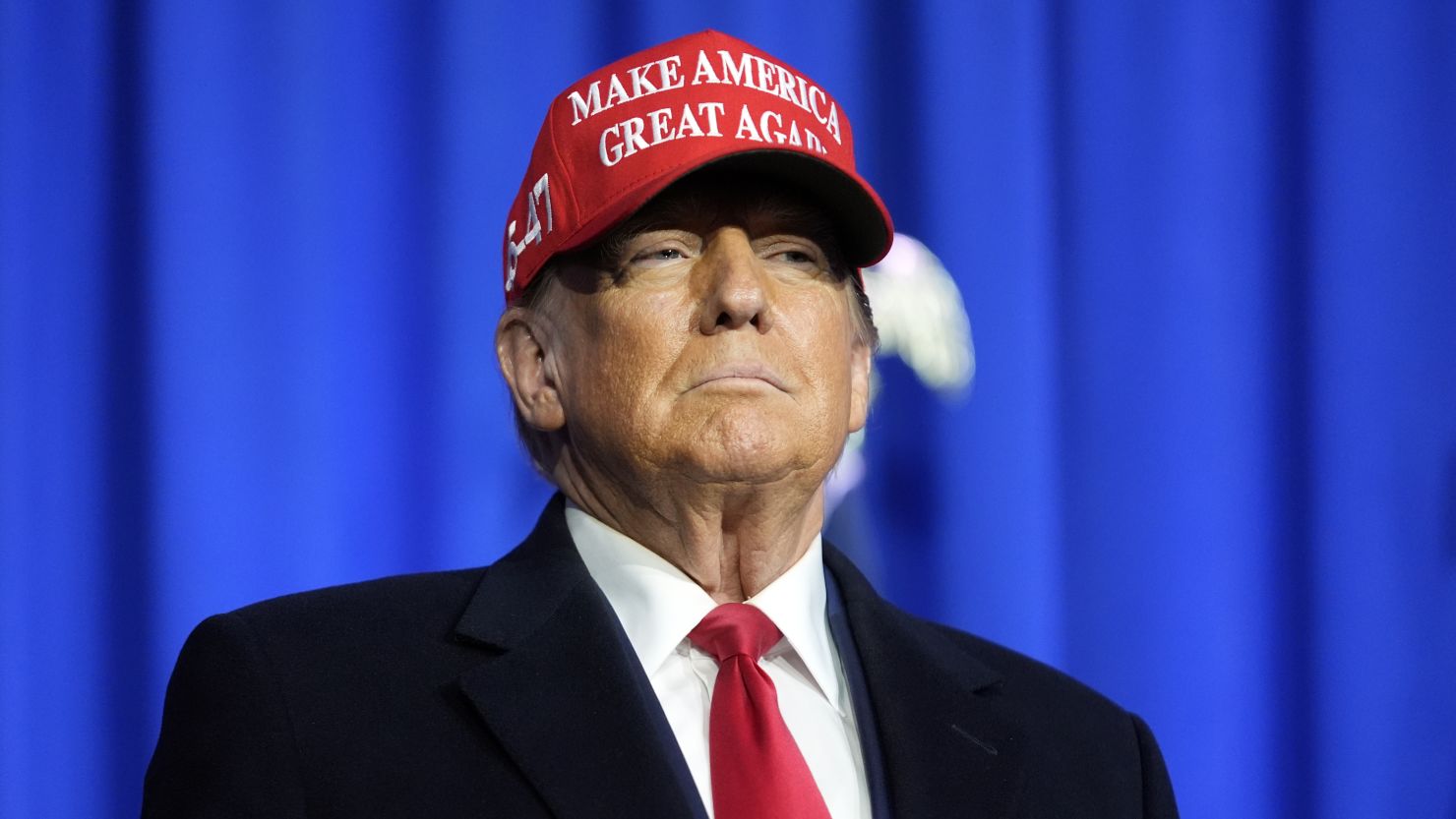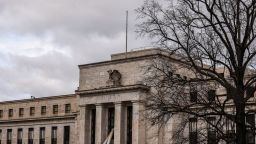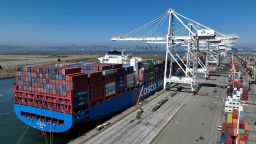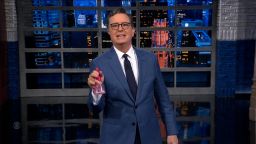Tariff Man could be back in the White House next year – and he’s promising the sequel will be even bigger than the original.
Former President Donald Trump, who labeled himself “Tariff Man” in 2018, has made clear he wants to pursue a more aggressive trade strategy if he’s elected in November. Trump has floated a 10% across-the-board tariff on imports, a 60% tariff on imports from China and a 100% tariff on foreign cars – including from Mexico.
Trump’s proposals, if enacted, could easily set off a new trade war with China and potentially other nations, too.
Some economists are warning Trump’s trade agenda and the ensuing retaliation from trading partners would hurt the US economy by worsening inflation, killing jobs, depressing growth and spooking investors.
In a worst-case scenario, economists fear these policies could set the stage for a recession.
“The policy is very bad. Tariffs make consumers poorer. They shrink the economy,” Alex Durante, an economist at the Tax Foundation, a right-leaning think tank, told CNN in a phone interview. “This would probably be the most damaging part of a Trump 2.0 economic agenda.”
How damaging? It’s hard to say exactly because there is a lot of uncertainty over how much of Trump’s proposed agenda would actually be enacted. And it’s possible Trump could offset the trade pain by cutting taxes.
Still, even if Trump used the tariff revenue to fund tax cuts, his proposals for a 10% tariffs on imports and a 60% tariff on Chinese goods would cost the US economy 675,000 jobs, wipe out 0.6 percentage points from US gross domestic product (the broadest measure of the economy) and boost the unemployment rate by 0.4 percentage points, according to Moody’s projections shared first with CNN.
“If Trump increases tariffs as he has proposed, the economy would likely suffer a recession soon thereafter,” said Mark Zandi, chief economist at Moody’s, adding that this includes the impact of very likely retaliation from other nations.
Inflation, a sore spot for families and the economy at large, would increase by 0.7 percentage points in the year after the tariffs are implemented, according to Zandi’s forecasts.
Goldman Sachs told clients in a recent report that higher tariffs would likely slow GDP growth and boost consumer prices.
“The direct impact of higher tariffs on GDP is likely to be modestly negative, with the hit to real income and consumer spending from higher prices outweighing the decline in the trade deficit,” Goldman Sachs economists led by Jan Hatzius wrote.
There would also likely be knock-on effects that could do further damage to the economy.
“The 2018-2019 experience suggests that there would likely also be negative indirect effects, including a tightening of financial conditions, a hit to business sentiment and an increase in trade policy uncertainty,” Goldman economists wrote.
The Wall Street bank cautioned, however, that there is “substantial uncertainty about the size and scope” of tariff increases and what products would be excluded from the levies.
Trump would have enormous power on trade
To be sure, Trump has legitimate gripes with China on the trade front.
Many Democrats and business leaders are similarly concerned about China’s alleged intellectual property theft, efforts by Beijing to force American companies to hand over their technology and “dumping” goods at artificially cheap prices.
US Treasury Secretary Janet Yellen, President Joe Biden’s point person on the economy, focused on China’s troubling overcapacity during a high-profile visit to China this week.
Karoline Leavitt, a spokesperson for the Trump campaign, told CNN in a statement that Trump cut regulations and taxes and used the leverage of the United States to “negotiate better trade deals around the world” and build the “strongest economy in American history.”
“In just three years, Joe Biden’s out of control spending created the worst inflation crisis in generations which hurt small businesses, resulted in increased layoffs, and many Americans losing their jobs to cheap foreign labor overseas,” Leavitt said. “When President Trump is back in the White House, he will reimplement his America First, pro-growth, pro-job agenda and uplift all Americans.”
In response, the Biden campaign criticized Trump’s economic track record, but did not directly address the impact of his trade plans.
“Donald Trump had the worst economic record of any president in modern American history, losing jobs and exploding the national debt. His plans for a second term will decimate the middle class,” Biden campaign spokesperson James Singer told CNN in a statement. “The Trump campaign is clearly confused, because under President Biden’s leadership, unemployment has hit record lows and 15 million new jobs have been created.”
As with many things related to Trump, experts said it’s hard to know how much of Trump’s tough talk on trade is real and how much of it is bluster. But Trump’s last term in the White House showed that he would have the power to ramp up the trade battle with China if he chooses to.
“The president really does have a lot of unilateral authority to do whatever he wants on trade. That’s deeply concerning,” said Durante, the Tax Foundation economist.
Of course, the economy is in a very different place today than it was in 2016 when Trump was first on the campaign trail advocating a forceful trade strategy against China and later when he imposed steep tariffs.
Back then, inflation was very low and interest rates were near-zero. Consumer prices increased just 2.1% in 2017, according to the Bureau of Labor Statistics. If anything, central bankers at the time were concerned inflation was too low, a problem that sounds quaint in hindsight.
‘Particularly ill-timed’
Now, Americans are still grappling with a large spike in prices compared with before the pandemic.
Although inflation has cooled since hitting a four-decade high of 9.1% in June 2022, it remains stubbornly high. And that is raising concerns over whether the Federal Reserve will be able to cut interest rates anytime soon.
Lobbing new tariffs on China and other countries right now would cause a one-time boost to the rate of inflation – a risky strategy given concerns about the cost of living and borrowing costs.
“This would be particularly ill-timed,” said Joe Brusuelas, chief economist at RSM, referring to tariffs. “Risks around inflation linked to tariffs are demonstrably higher today than in 2016. When I watch both campaigns talk about tariffs, I’m concerned that political actors don’t adequately understand just how decisively different the global economy is today.”
Brusuelas said that a new round of tariffs would act as a “tax on all US consumers.”
“This would be felt most notably by your Target and Walmart because there is no ready substitute for these goods,” he said, referring to Trump’s 60% tariff proposal.
Brusuelas suggested Trump could face a Liz Truss moment, referring to the UK prime minister whose plan for massive tax cuts stunned financial markets and helped make her Britain’s shortest-serving prime minister.
“Instead of bond vigilantes, you could get trade vigilantes,” he said.
Maury Obstfeld, senior fellow at the Peterson Institute for International Economics, agrees that massive new tariffs “could have a destabilizing effect on financial markets.”
“Clearly, China would retaliate massively. Other trading partners would be unlikely to take it laying down,” said Obstfeld, a former official at the International Monetary Fund (IMF) and in the Obama administration.
Who pays for tariffs?
Trump has repeatedly suggested other nations are paying for US tariffs. In reality, experts say it’s US consumers and businesses who pay the levy. That’s because tariffs tax imports when they come ashore, adding costs for US distributors, retailers and, ultimately consumers.
“The 2018-2019 tariffs clearly raised consumer prices,” Goldman Sachs economists wrote in their recent report, adding that these price increases were “borne almost entirely by US businesses and households” – not Chinese exporters.
Likewise, the US International Trade Commission said in a 2023 study that US importers “bore nearly the full cost” of the tariffs.
Worse, some businesses appeared to take advantage of the trade war by bumping up prices even higher.
Goldman Sachs found that tariffs allowed US producers and non-Chinese exporters to the US market to “opportunistically raise their prices as well.”
‘Trade has become toxic’
Even Biden has been searching for ways to ease inflation; his administration has not abandoned the Trump trade strategy.
US tariffs on China remain in place and there has been little movement towards removing them. Steel and aluminum tariffs are also still intact.
“Lowering tariffs would be a benefit to consumers. But there is no political appetite to turn these things back at the moment,” said Obstfeld, the former Obama official. “Trade has become toxic – to both parties.”
Durante, the Tax Foundation economist, agreed that politics explains why tariffs have become a bipartisan strategy.
“The policy itself is not working, but it sounds really good,” he said.









